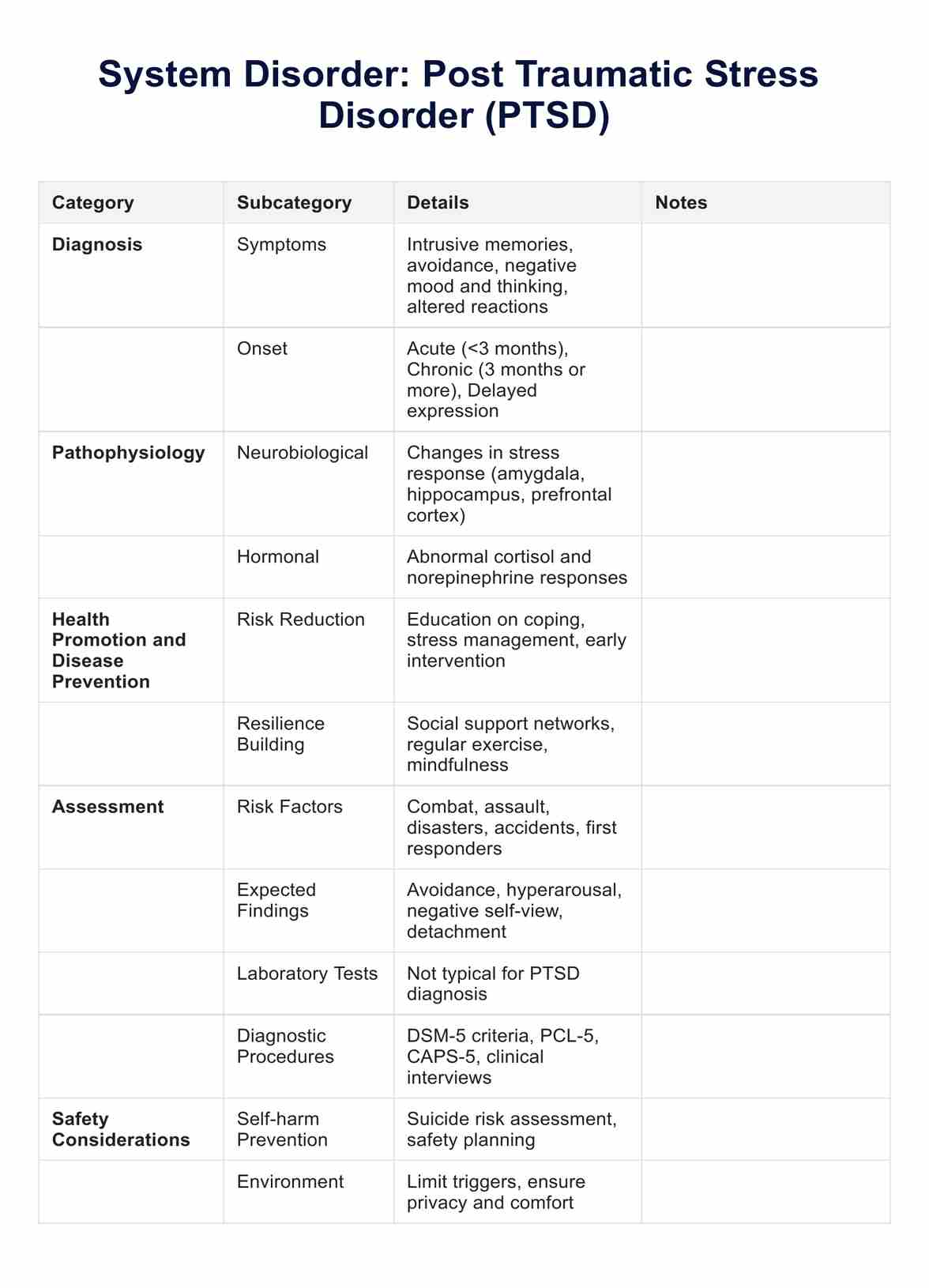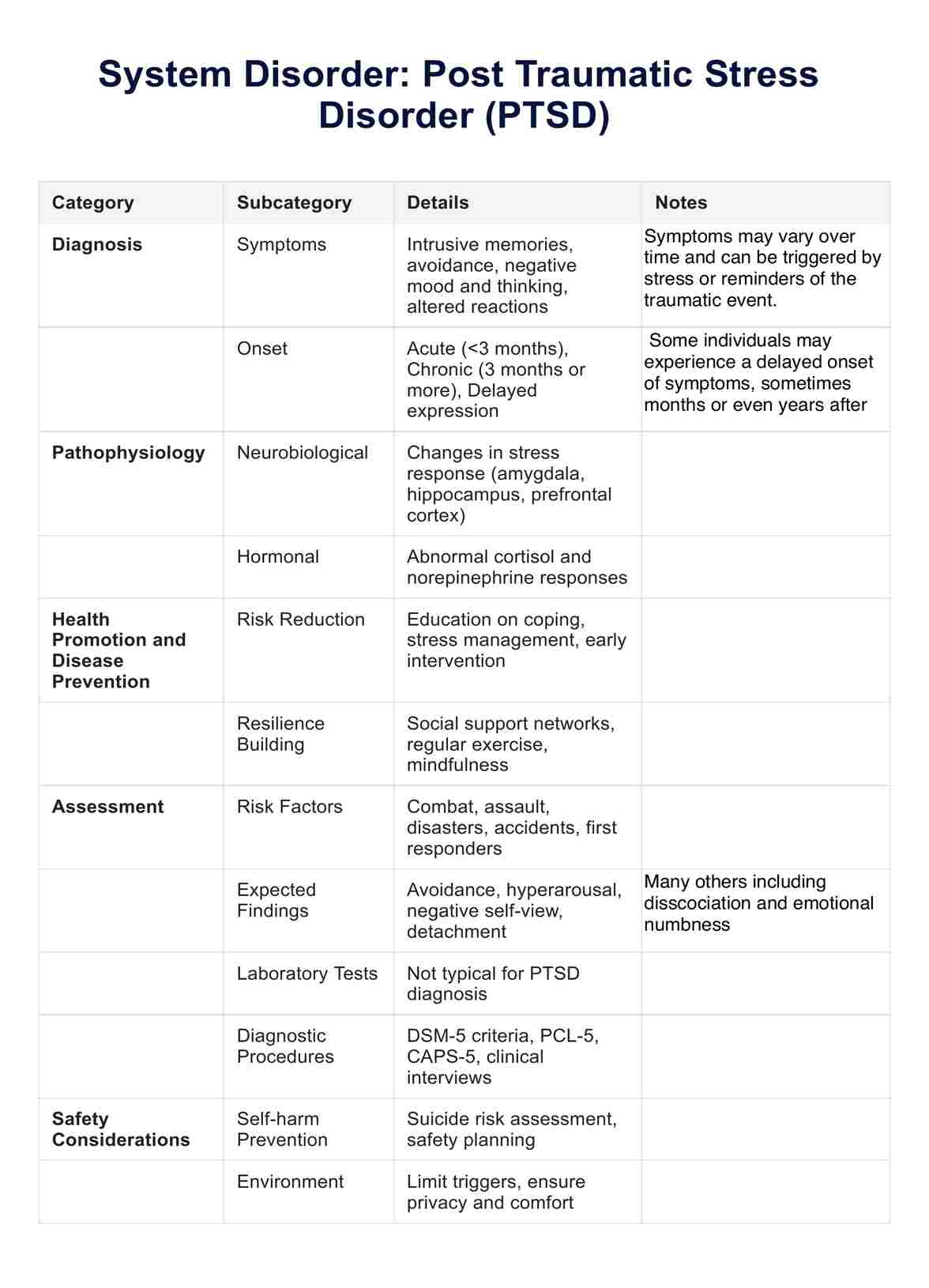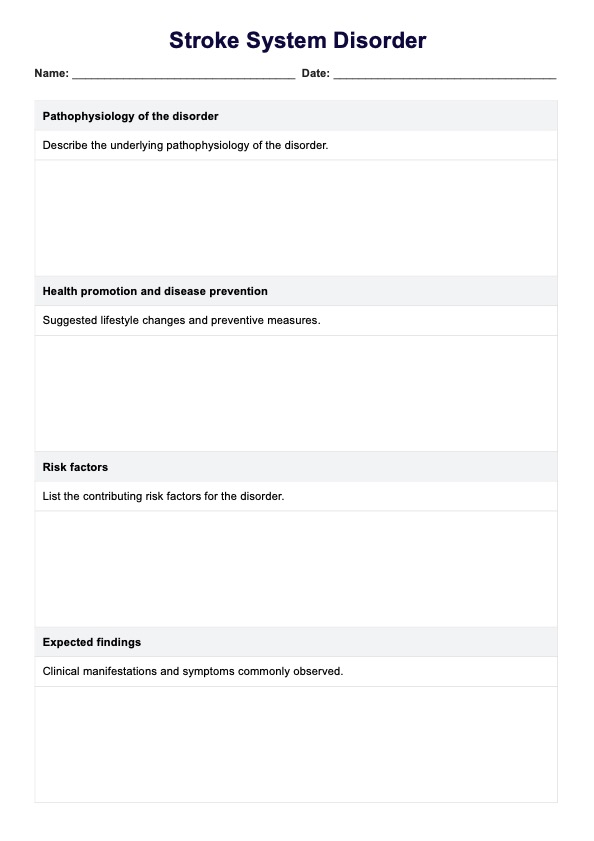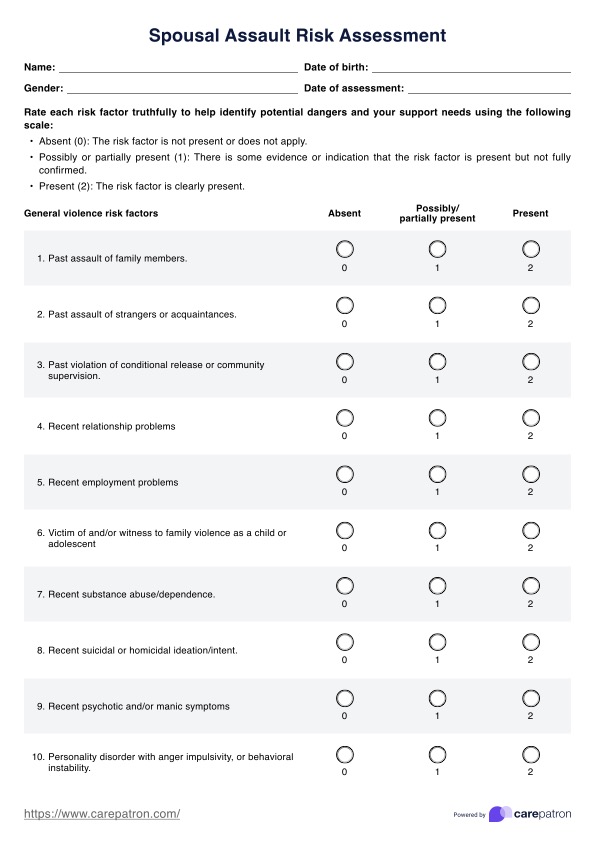PTSD System Disorder Template
Explore our comprehensive PTSD System Disorder Template, designed for mental health professionals to effectively assess and revise PTSD symptoms.


What is a PTSD System Disorder Template?
Post-Traumatic Stress Disorder (PTSD) is a mental health condition triggered by experiencing or witnessing a terrifying or traumatic event. Symptoms may include flashbacks, nightmares, severe anxiety, and uncontrollable thoughts about the event.
The Post-Traumatic Stress Disorder (PTSD) system disorder template is a comprehensive tool that encapsulates various critical aspects of PTSD. It begins with the diagnosis, relying on specific criteria to identify the disorder based on its characteristic symptoms like flashbacks, nightmares, and severe anxiety. These symptoms are pivotal in distinguishing PTSD from other mental health conditions.
The template delves into the pathophysiology of PTSD, shedding light on the neurobiological and hormonal changes that occur in response to trauma. This insight is crucial for understanding the complexities of the disorder and guiding treatment strategies. It also highlights the importance of health promotion and disease prevention, emphasizing interventions like stress management, coping education, and resilience-building activities.
Assessment is another key component, where the template outlines risk factors associated with PTSD, such as exposure to combat, assault, or disasters. It also describes the expected findings in individuals with PTSD, aiding in accurate diagnosis and tailored treatment plans. Despite the lack of typical laboratory tests for PTSD, the template includes diagnostic procedures based on the DSM-5 criteria and other clinical interviews.
Patient care is addressed comprehensively, emphasizing safety considerations, especially in terms of self-harm and suicide prevention. It suggests trauma-informed care practices, medication options, and therapeutic procedures like EMDR and trauma-focused CBT. The role of interprofessional care is also underscored, highlighting the importance of coordination among mental health professionals.
Finally, the template covers potential complications of PTSD, including comorbid conditions like substance abuse and depression, and underscores the risk of chronicity in symptoms.
This template serves as a vital tool for healthcare professionals, aiding them in revising and understanding the essential components of PTSD. It provides a structured approach to the disorder, ensuring that all critical aspects are considered in the diagnosis, treatment, and management. By using a PTSD System Disorder Template, healthcare professionals can ensure a comprehensive and consistent approach to treating patients with PTSD, incorporating evidence-based practices and current research into their care plans. This resource ultimately aims to improve patient outcomes through structured and informed care delivery.
PTSD System Disorder Template
PTSD System Disorder Template Example
How does it work?
Utilizing a Printable PTSD System Disorder Template is a valuable tool for healthcare professionals to systematically approach the diagnosis, management, and treatment of Post-Traumatic Stress Disorder (PTSD). It ensures a comprehensive understanding of the disorder, aiding in the delivery of effective patient care. Here's a step-by-step guide to accessing and using this template:
Step 1: Download the printable PTSD System Disorder Template
- Access: Obtain the template through a provided link or a professional resource. Ensure it’s from a reliable source to maintain accuracy and relevance.
- Viewing the Template: The template typically opens in a standard PDF reader, allowing for easy digital viewing and interaction.
- Printing Option: For those who prefer a physical copy, the template is designed to be printer-friendly. This can be useful for consultations, team discussions, or patient education.
Step 2: Familiarize yourself with the PTSD framework
- Understanding PTSD: Review the template to gain insights into the various aspects of PTSD, including symptoms, pathophysiology, and assessment criteria.
- Identifying Key Components: Take note of important elements such as diagnostic criteria, treatment options, and risk factors associated with PTSD.
Step 3: Apply the template in clinical practice
- Assessment and Diagnosis: Use the template as a guide during patient assessments to ensure a thorough evaluation of potential PTSD cases.
- Treatment Planning: Refer to the treatment and management sections to formulate individualized care plans based on best practices and patient-specific needs.
- Monitoring Progress and Complications: The template can assist in tracking patient progress and identifying any complications or comorbidities that may arise.
By following these steps, healthcare professionals can enhance their understanding and management of PTSD. The template serves not only as a guide but also as a comprehensive reference tool, ensuring that all critical aspects of PTSD are considered and addressed in patient care. This systematic approach is invaluable for both new and experienced practitioners in delivering quality care to those affected by PTSD.
When would you use this Template?
The PTSD System Disorder Template is an essential resource for a wide range of healthcare practitioners who encounter patients with Post-Traumatic Stress Disorder (PTSD). This template is particularly useful in various clinical settings and scenarios, emphasizing its versatility and applicability in enhancing patient care.
Initial assessment of PTSD:
Mental health professionals, including psychiatrists, psychologists, and counselors, can use the template during the initial assessment of patients presenting with symptoms suggestive of PTSD. It provides a structured approach to ensure all relevant aspects of the disorder are considered, from symptomatology to risk factors.
Routine follow-up and monitoring:
For ongoing patient management, the template is invaluable in routine follow-up appointments. It helps in tracking the progress of the disorder and the effectiveness of treatment strategies, ensuring a comprehensive evaluation over time.
Training and education:
For educational purposes, the template is a useful tool in training new clinicians and healthcare students. It provides a clear, concise overview of PTSD, making it easier for learners to understand and remember the key aspects of this complex disorder.
In summary, the PTSD System Disorder Template is a versatile and valuable resource for healthcare professionals dealing with PTSD. Its use spans from initial assessment and routine monitoring to interdisciplinary coordination, education, research, and personalized care planning. This template not only standardizes the approach to PTSD but also enriches the quality of care provided to patients suffering from this challenging disorder.
What are the benefits and limitations of this template?
The Free PTSD System Disorder Template is a valuable resource for healthcare providers managing patients with Post-Traumatic Stress Disorder. It offers several benefits but also comes with certain limitations.
Benefits
- Structured Approach: The template provides a systematic and structured approach to diagnosing and managing PTSD. It ensures that all critical aspects of the disorder, from symptoms to treatment options, are thoroughly considered.
- Standardization of Care: By offering a standardized framework, the template helps in maintaining consistency in the quality of care across different healthcare settings. This is particularly beneficial in ensuring that patients receive comprehensive and uniform care.
- Educational Tool: For new clinicians and students, the template serves as an excellent educational resource, providing a clear overview of PTSD and its management. It facilitates learning and retention of key concepts related to the disorder.
- Enhanced Communication: In multidisciplinary teams, the template aids in enhancing communication among healthcare professionals by providing a common reference point, thereby improving coordination in patient care.
- Personalized Treatment Plans: The template allows for the development of individualized treatment plans, tailored to the specific needs of each patient, which can lead to better treatment outcomes.
Limitations
- Generic Framework: While the template covers a broad range of aspects, it may not encompass every unique case of PTSD. Certain individual patient nuances might require deviation from the template.
- Dependence on Clinical Judgment: The effectiveness of the template relies heavily on the clinician’s judgment and experience. It is a guide, but not a substitute for professional clinical decision-making.
- Potential for Over-Reliance: There's a risk of over-reliance on the template, which might lead to a checkbox approach to patient care, potentially overlooking the holistic and dynamic nature of PTSD.
The Free PTSD System Disorder Template is a beneficial tool for standardizing and enhancing the care of PTSD patients. It supports structured assessment, education, and treatment planning. However, it should be used as a complement to, and not a replacement for, professional clinical judgment and personalized care. Keeping the template updated and ensuring its flexible application to suit individual patient needs is crucial for maximizing its effectiveness.
Research & evidence of PTSD System Disorder Template
The PTSD System Disorder Template can play an instrumental role in the treatment and management of Post-Traumatic Stress Disorder, drawing support from a broad spectrum of research and clinical best practices. Its significance and the ideas supporting its use are multifaceted:
Evidence-based structure:
The template is grounded in evidence-based practices, integrating guidelines and recommendations from leading mental health organizations and research studies. This ensures that the care provided to PTSD patients is in line with the latest scientific findings and clinical standards (Schrader & Ross, 2021; Mann & Marwaha, 2023).
Comprehensive assessment:
Research underscores the complexity of PTSD, which involves a range of symptoms and co-occurring disorders. The template's comprehensive nature ensures that all aspects of the disorder are assessed and managed, aligning with studies that emphasize a holistic approach to PTSD care (Martin et al., 2021).
Standardization of care:
Studies have shown that standardization in mental health care can lead to better patient outcomes. The template contributes to this by providing a consistent framework for diagnosing and treating PTSD, thereby enhancing the quality and effectiveness of care (Schrader & Ross, 2021).
Interdisciplinary collaboration:
The template supports interdisciplinary collaboration, a practice highly recommended in PTSD treatment. It serves as a common tool that various healthcare professionals can use, facilitating better communication and coordinated care, which is crucial for complex disorders like PTSD (Watkins et al., 2018;Mann & Marwaha, 2023).
Patient-centered care:
The template is aligned with the idea of patient-centered care, an approach increasingly recognized as vital in mental health treatment. By providing a framework that can be tailored to individual patient needs, the template supports personalized care plans, which research indicates are more effective (Mann & Marwaha, 2023).
Guidance for treatment planning:
The inclusion of evidence-based treatment options within the template offers clinicians a guide to the most effective interventions for PTSD. This is particularly important given the rapidly evolving nature of PTSD treatment research (Mann & Marwaha, 2023).
In summary, the PTSD System Disorder Template is a valuable resource for healthcare providers, grounded in a wealth of research and best practice ideas. It ensures comprehensive, standardized, interdisciplinary, and patient-centered care, all of which are key to effective PTSD management and treatment.
References
Mann, S. K., & Marwaha, R. (2023). Posttraumatic Stress Disorder. In StatPearls. StatPearls Publishing.
Martin, A., Naunton, M., Kosari, S., Peterson, G., Thomas, J., & Christenson, J. K. (2021). Treatment Guidelines for PTSD: A Systematic Review. Journal of clinical medicine, 10(18), 4175. https://doi.org/10.3390/jcm10184175
Schrader, C., & Ross, A. (2021). A Review of PTSD and Current Treatment Strategies. Missouri medicine, 118(6), 546–551.
Watkins, L. E., Sprang, K. R., & Rothbaum, B. O. (2018). Treating PTSD: A Review of Evidence-Based Psychotherapy Interventions. Frontiers in behavioral neuroscience, 12, 258. https://doi.org/10.3389/fnbeh.2018.00258
Commonly asked questions
The PTSD System Disorder Template is a structured tool designed for healthcare professionals. It guides the assessment, diagnosis, and treatment of Post-Traumatic Stress Disorder (PTSD). The template includes various sections covering symptoms, diagnosis criteria, treatment options, and patient care strategies.
This template is beneficial for psychiatrists, psychologists, counselors, nurses, and other healthcare providers involved in the management of PTSD. It's also a valuable educational resource for medical students and trainees.
The template standardizes the approach to diagnosing and treating PTSD, ensuring that all critical aspects of the disorder are considered. It aids in developing comprehensive treatment plans and facilitates communication among multidisciplinary teams.






















-template.jpg)





















































































